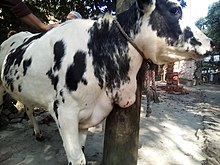

East Coast fever, also known as theileriosis, is a disease of cattle which occurs in Africa and is caused by the protozoan parasite Theileria parva. The primary vector which spreads T. parva between cattle is a tick, Rhipicephalus appendiculatus.[1] East Coast fever is of major economic importance to livestock farmers in Africa,[2] killing at least one million cattle each year.[3] The disease occurs in Burundi, Democratic Republic of Congo, Kenya, Malawi, Mozambique, Rwanda, South Sudan, Tanzania, Uganda, Zimbabwe, Zambia.[3] In 2003, East Coast fever was introduced to Comoros by cattle imported from Tanzania.[4] It has been eradicated in South Africa.[3]
A more acute form of East Coast fever called corridor disease occurs when buffalo-derived T. parva is transmitted to cattle.[3] Another form, called January disease, only occurs over the winter months in Zimbabwe due to the tick lifecycle.[citation needed]
Native cattle are often resistant to the parasite, but not without symptoms. They are hosts to the parasite, but do not suffer as severely as foreign cattle.[5][6]
- ^ Olwoch JM, Reyers B, Engelbrecht FA, Erasmus BF (2008). "Climate change and the tick-borne disease, Theileriosis (East Coast fever) in sub-Saharan Africa". Journal of Arid Environments. 72 (2): 108–20. doi:10.1016/j.jaridenv.2007.04.003.
- ^ "Protecting Africa's cattle with a live vaccine: An East Coast fever impact narrative". ILRI Research Brief. No. 24. International Livestock Research Institute. September 2014. Retrieved 2018-05-06.
- ^ a b c d Nene, V; Kiara, H; Lacasta, A; Pelle, R; Svitek, N; Steinaa, L (June 2016). "The biology of Theileria parva and control of East Coast fever - Current status and future trends". Ticks and Tick-borne Diseases. 7 (4): 549–64. doi:10.1016/j.ttbdis.2016.02.001. PMID 26972687.

- ^ Gachohi, J; Skilton, R; Hansen, F; Ngumi, P; Kitala, P (7 September 2012). "Epidemiology of East Coast fever (Theileria parva infection) in Kenya: past, present and the future". Parasites & Vectors. 5: 194. doi:10.1186/1756-3305-5-194. PMC 3465218. PMID 22958352.
- ^ Norval RA, Perry BD, Young AS (1992). The Epidemiology of Theileriosis in Africa. London: Academic Press. ISBN 978-0-12-521740-8.
- ^ International Livestock Research Institute